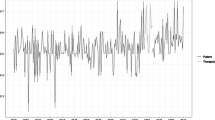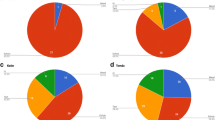Abstract
An approach to a functional analysis of delusional speech and hallucinatory behavior is described and discussed using concepts found in Goldiamond’s (1975a and 1984) nonlinear contingency analysis and Skinner’s Verbal Behavior (1957). This synthesis draws upon and concords with research from the animal laboratory, with the extensive experimental literatures on stimulus control and signal detection theory, and with our own clinical experiences.
In this formulation, delusional speech and hallucinatory behavior are viewed as successful operants. Accordingly, we argue that such behaviors can be considered adaptive and rational, rather than maladaptive and irrational, when analyzed within a model of consequential governance that includes alternative sets of contingencies. Several clinical examples are offered to illustrate both analytic procedures and the design of systemic treatment programs based upon a behavioral contingency analysis derived from a natural science of behavior. Throughout, we emphasize the consequential governance of these clinically important classes of behavior, in contrast to other approaches which suggest formal similarities to operant verbal behavior but largely ignore the role of consequential contingencies.
Similar content being viewed by others
References
Adler, A. (1931). What life should mean to you. New York: Putnam & Sons.
Aesop (620–560 BC). The little boy who cried wolf. In Aesop’s Fables: Illustrated Junior Library, (p. 132) Grosset & Dunlap, New York (1947).
Andronis, P. T. (1983). Symbolic aggression by pigeons: Contingency coadduction. Ph.D. dissertation. The University of Chicago.
Andronis, P. T., Goldiamond, I., & Layng, T. V. J. (1983). “Symbolic aggression” by pigeons: Contingency coadduction. Paper presented at the Ninth Annual Convention of the Association for Behavior Analysis, Milwaukee, WI, May 1983.
Andronis, P. T., & Goldiamond, I. (1983). Dominance, submission, and cooperation by pigeons. Paper presented at the Ninth Annual Convention of the Association for Behavior Analysis, Milwaukee, WI, May 1983.
Braginsky, B. M., Braginsky, D. D., & Ring, K. (1969). Methods of madness: The mental hospital as last resort. New York: Holt, Rinehart & Winston.
Braginsky, B. M., Grosse, G., & Ring, K. (1966). Controlling outcomes through impression management: An experimental study of the manipulative tactics of mental patients. Journal of Consulting Psychology, 30, 295–300.
Burns, C. E. S., Heiby, E. M., & Tharp, R. G. (1983). A verbal behavior analysis of auditory hallucinations. The Behavior Analyst, 6, 133–143.
Cullen, C., Hattersley, J., & Tennant, L. (1981). Establishing behaviour: The constructional approach. In G. Davey (Ed.), Applications of conditioning theory (pp. 149–161). London: Methuen & Co., Ltd.
Cullen, J. (Ed.) (1974). Experimental behavior: A basis for the study of mental disturbance. New York: John Wiley & Sons.
Dunham, P. J., & Grantmyre, J. (1982). Changes in a multiple-response repertoire during response contingent punishment and response restriction: sequential relationships. Journal of the Experimental Analysis of Behavior, 37, 123–134.
Epstein, R. (1983). Resurgence of previously reinforced behavior during extinction. Behaviour Analysis Letters, 3, 391–397.
Epstein, R., & Skinner, B. F. (1980). Resurgence of responding after the cessation of response-independent reinforcement. Proceedings of the National Academy of Sciences, 77, 6251–6253.
Fairweather, G. W., Sanders, D. H., Maynard, H., & Cressler, D. L. (1969). Community life for the mentally ill. Chicago: Aldine Press.
Falk, J. L. (1971). The nature and determinants of adjunctive behavior. Physiology and Behavior, 6, 577–588.
Falk, J. L. (1977). The origins and functions of adjunctive behavior. Animal Learning and Behavior, 5, 325–335.
Ferster, C. B. (1972). The experimental analysis of clinical phenomena. The Psychological Record, 22, 1–16.
Fredriksen, L. W., & Peterson, G. L. (1977). Schedule induced aggression in humans and animals: a comparative parametric review. Aggressive Behavior, 3, 57–75.
Freedman, B. J. (1974). The subjective experience of perceptual and cognitive disturbances in schizophrenia. Archives of General Psychiatry, 30, 333–340.
Gambrill, E. (1977). Behavior modification: Handbook for application and assessment. San Francisco: Jossey-Bass.
Garza, R. de la, & Johanson, C. E. (1983). The discriminative stimulus properties of cocaine in the rhesus monkey. Pharmacology Biochemistry and Behavior, 19, 145–148.
Goldiamond, I. (1962). Perception. In A. Bachrach (Ed.), Experimental foundations of clinical psychology (pp. 280–340). New York: Basic Books, Inc.
Goldiamond, I. (1964). Response bias in perceptual communication. Disorders of communication, XLII, Research Publications, Association for Research in Nervous and Mental Disease, 334–363.
Goldiamond, I. (1970). Human control over human behavior. In M. Wertheimer (Ed.), Confrontation (pp. 254–306). Glenview, IL: Scott, Foresman.
Goldiamond, I. (1974). Toward a constructional approach to social problems: Ethical and constitutional issues raised by applied behavior analysis. Behaviorism, 2, 1–84.
Goldiamond, I. (1975a). Alternative sets as a framework for behavioral formulations and research. Behaviorism, 3, 49–86.
Goldiamond, I. (1975b). Insider-outsider problems: A constructional approach. Rehabilitation Psychology, 22, 103–116.
Goldiamond, I. (1975c). A constructional approach to self-control. In A. Schwartz and I. Goldiamond (Eds.), Social casework: A behavioral approach (pp. 67–130). New York: Columbia University Press.
Goldiamond, I. (1976). Protection of human subjects and patients: A social contingency analysis of distinctions between research and practice, and its implications. Behaviorism, 4, 1–41.
Goldiamond, I. (1979). Behavioral approaches and liaison psychiatry. Psychiatric Clinics of North America, 2, 379–401.
Goldiamond, I. (1984). Training parent trainers and ethecists in nonlinear analysis of behavior. In Dangle, R. F. & Polster, A. (Eds.), Foundations of research and practice, (pp. 504–545) New York: Gilford press.
Goldiamond, I., & Dyrud, J. E. (1967). Some applications and implication of behavioral analysis for psychotherapy. In J. Schlien (Ed.), Research in psychotherapy (pp. 54–89), Vol. III. Washington, D.C.: American Psychological Association.
Goldiamond, I., & Hawkins, W. A. (1958). Vexierversuch: the log relationship between word-frequency and recognition obtained in the absence of stimulus words. Journal of Experimental Psychology, 56, 457–463.
Goldiamond, I. and Thompson, D. (1968). The functional analysis of behavior. Institute for Behavioral Research, Silver Springs, Maryland.
Gould, L. (1950). Verbal hallucinations as automatic speech: The reactivation of dormant speech habit. American Journal of Psychiatry, 107, 110–117.
Green, D. M., & Swets, J. A. (1973). Signal detection theory and psychophysics. Second Edition. Huntington, NY: R. E. Krieger Pub. Co., Inc.
Green, S. (1983). Animal models in schizophrenia research. In G. Davey (Ed.), Animal models of human behavior (pp. 315–338). New York: John Wiley & Sons.
Isaacs, W., Thomas, J., & Goldiamond, I. (1960). Application of operant conditioning to reinstate verbal behavior in psychotics. Journal of Speech and Hearing Disorders, 25, 8–12.
Keehn, J. D. (Ed.) (1979). Origins of madness: Psychopathology in animal life. New York: Pergamon Press.
Kimmel, K. D. (Ed.) (1971). Experimental psychopathology: Recent research and theory. New York: Academic Press.
Layng, T. V. J., Merley, S., Cohen, J., Andronis, P. T., and Layng, M. (1976). Programed instruction, self-control, and in-patient psychiatry. Educational Resource Clearing House (ERIC), Document listing #142 886.
Layng, T. V. J., Goldiamond, I., & Andronis, P. T. (1983). Social behaviors and behaviors of social consequence: Headbanding by pigeons. Paper presented at the Ninth Annual Convention of the Association for Behavior Analysis, Milwaukee, WI, May 1983.
Looney T. A., & Cohen P. S. (1982). Aggression induced by intermittent positive reinforcement. Biobehavioral Reviews, 6, 15–37.
Lyon, D. O. (1982). Concurrent behaviors: are the interpretations mutually exclusive? The Behavior Analyst, 5, 175–187.
Mauldin, M., Karp, H., & Layng, T. V. J. (1979). The discrimination of sexy and friendly interpersonal cues: A signal detection analysis. Paper presented at the Fifth Annual Convention of the Association for Behavior Analysis, Dearborn, MI, June 1979.
McGuigan, F. (1966). Covert oral behavior and auditory hallucinations. Psychophysiology, 3, 73–80.
Merley, S., & Layng, T. V. J. (1976). In-patient psychiatry and programed instruction: Application and research in constructional theory. Improving Human Performance Quarterly, 5, 35–46.
Michael, J. L. (1982). Distinguishing between discriminative and motivational functions of stimuli. Journal of the Experimental Analysis of Behavior, 37, 149–155.
Neisser, U. (1967). Cognitive psychology. Englewood Cliffs, NJ: Prentice-Hall, Inc.
Paul, G., & Lentz, R. (1977). Psychosocial treatment of chronic mental patients: Milieu versus social-learning programs. Cambridge, MA: Harvard University Press.
Pavlov, I. P. (1903). Psychopathology and psychiatry: Selected works. Moscow: Foreign Language Publishing House.
Reynolds, G. S. (1961). Attention in the pigeon. Journal of the Experimental Analysis of Behavior, 4, 57–71.
Salzinger, K. (1973). Schizophrenia: Behavioral aspects. New York: John Wiley & Sons, Inc.
Schuster, C. R., Fischman, M. W., & Johanson, C. E. (1981). Internal stimulus control and subjective effects of drugs. Behavioral Pharmacology of Human Drug Dependence, 37, Research Monograph Series, National Institute on Drug Abuse, 116–129.
Sidman, M. (1961). Normal sources of pathological behavior. Science, 132, 61–68.
Skinner, B. F. (1936). The verbal summator and a method for the study of latent speech. Journal of Psychology, 2, 71–107.
Skinner, B. F. (1953). Science and human behavior. New York: The Free Press.
Skinner, B. F. (1957). Verbal behavior. Englewood Cliffs, NJ: Prentice-Hall.
Staddon, J. E. R. (1977). Schedule-induced behavior. In Honig, W. and Staddon, J. E. R. (Eds.), Handbook of operant behavior (pp. 125–152). New York: Appleton-Century-Crofts.
Stoddard, L. T., & Sidman, M. (1971). The removal and restoration of stimulus control. Journal of the Experimental Analysis of Behavior, 16, 143–154.
Tennant, L., Cullen, C., & Hattersley, J. (1981). Applied behaviour analysis: Intervention with retarded people. In G. Davey (Ed.), Applications of conditioning theory (pp. 29–58). London: Methuen & Co., Ltd.
Watson, J. B. (1924). Behaviorism. New York: The People’s Institute Publishing Company, Inc.
Zubin, J., & Hunt, H. F. (Eds.) (1967). Comparative psychopathology: Animal and human. New York: Grune & Stratton.
Author information
Authors and Affiliations
Additional information
We fondly dedicate this paper to Izzy Goldiamond, whose friendship and writings have pervaded our work almost from the outset.
Rights and permissions
About this article
Cite this article
Layng, T.V.J., Andronis, P.T. Toward a Functional Analysis of Delusional Speech and Hallucinatory Behavior. BEHAV ANALYST 7, 139–156 (1984). https://doi.org/10.1007/BF03391897
Published:
Issue Date:
DOI: https://doi.org/10.1007/BF03391897




